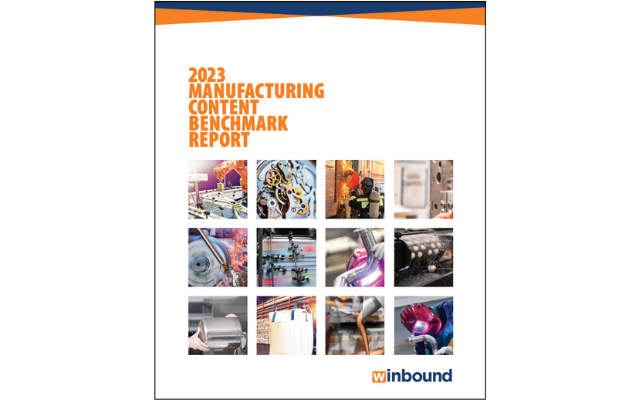Winbound reviewed over 400 manufacturing websites and evaluated their use of content throughout their customers’ sales and marketing journey.
The inescapable conclusion is that the majority of websites didn’t have key content assets, and those that did weren’t keeping them current.
This means that a significant number of manufacturers are not aligned with how customers are buying today. And just as important, these manufacturers risk being outperformed by peer companies who are actively using content in their sales and marketing efforts.
In this post, we’ll provide key findings from the research and also share reactions from industry experts. Here’s a brief video with an overview:
Our goal with the research: Are manufacturers actually using content?
This research was actually prompted by previous research we’ve reported on annually from the Content Marketing Institute. Every year, CMI asks manufacturing marketers to share the results of their content marketing efforts, and, typically, these marketers are generating positive numbers.
Consider results like the following from last year. Among manufacturing marketers who regularly use content:
- 88% created brand awareness
- 67% built credibility/trust
- 63% educated their audience
Good stuff. But that research was conducted with manufacturers who were actively using content in their marketing efforts. It begged the question that led to this report:
Just how many manufacturers are actually using content in the first place?
What we reviewed and whose websites we reviewed
To answer that question, we looked at more than 420 websites of small, mid-sized, and large manufacturers. (Small manufacturers were classified as less than $25 million in revenue; mid-sized manufacturers were $25 million–$100 million; and large manufacturers were more than $100 million.)
We looked to see if content assets were present in three critical stages of the sales and marketing process:
- Do manufacturers have “top-of-funnel” content that creates awareness and gets prospects to Know You?
- Do manufacturers have “middle-of-funnel” content that provides insights and gets prospects to Like You?
- Do manufacturers have “bottom-of-funnel” content, such as case studies and testimonials, that gets prospects to Trust You?
Note that we not only looked to see if these content assets were present but also if they were actively updated (and we were extremely generous in our definitions of “active”).
Key results: Most manufacturers aren’t using digital content
Given that manufacturing is typically a sales-driven industry, we weren’t entirely shocked to see the following numbers. Nevertheless, they are extremely low, especially when you consider all the research indicating that B2B customers are looking online for product and service solutions.
Consider that over 57% percent of the customer journey will be completed before a meaningful interaction with a salesperson (source: Challenger Sales Model). That’s a lot of B2B customers looking online for answers, right?
Yet our research showed:
- Only 33% of all manufacturers – and this includes some of the country’s biggest manufacturers – had regularly updated top-of-funnel content, which is typically found on blogs, YouTube channels, or social media.
- Only 47% had middle-of-funnel content, like white papers, guides, or checklists.
- Only 20% had bottom-of-funnel content, such as case studies, testimonials, and pricing.
Now let’s break some of those numbers down further, and get some expert reactions on why these are important.
Just over 21% of manufacturers have an active blog
Blogs typically contain articles and in-depth answers to customer questions. They can attract traffic from search engines and can be used for thought leadership.
Yet only 25.7% of manufacturers have a blog, and only 21.3% of manufacturers have an active blog.
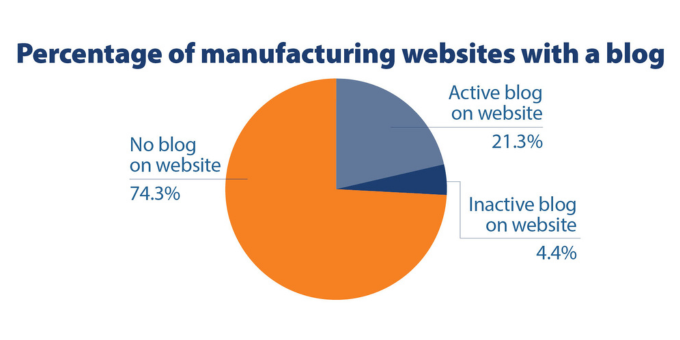
This runs counter to B2B companies overall. According to a survey from the Content Marketing Institute, 62% of top performing B2B marketers said they’ve used content marketing successfully to generate sales/revenue in the last 12 months, and 80% of these top performers use blogs.
Andy Crestodina of Orbit Media notes websites with content programs that engage in SEO are nearly twice as likely to report success as those that do not. He believes that if you’re not producing content:
You are deliberately letting your competitors win that huge amount of visibility and traffic.
Curt Anderson of B2Btail says that in the era of online self-service, blogging can help you reach the ultimate goal:
Provide all the necessary information to help your ideal prospect make a buying decision on a Friday night at midnight without needing to wait for you to open your doors on Monday morning.
22% of manufacturers have a YouTube page, but just over 11% actively post to it
Videos are considered one of the most effective forms of content for manufacturers, according to the CMI report we cited earlier.
Yet only 22% of manufacturers have a YouTube page. Of that number, only 11% are active, or have posted to the channel at least once in the last three months.
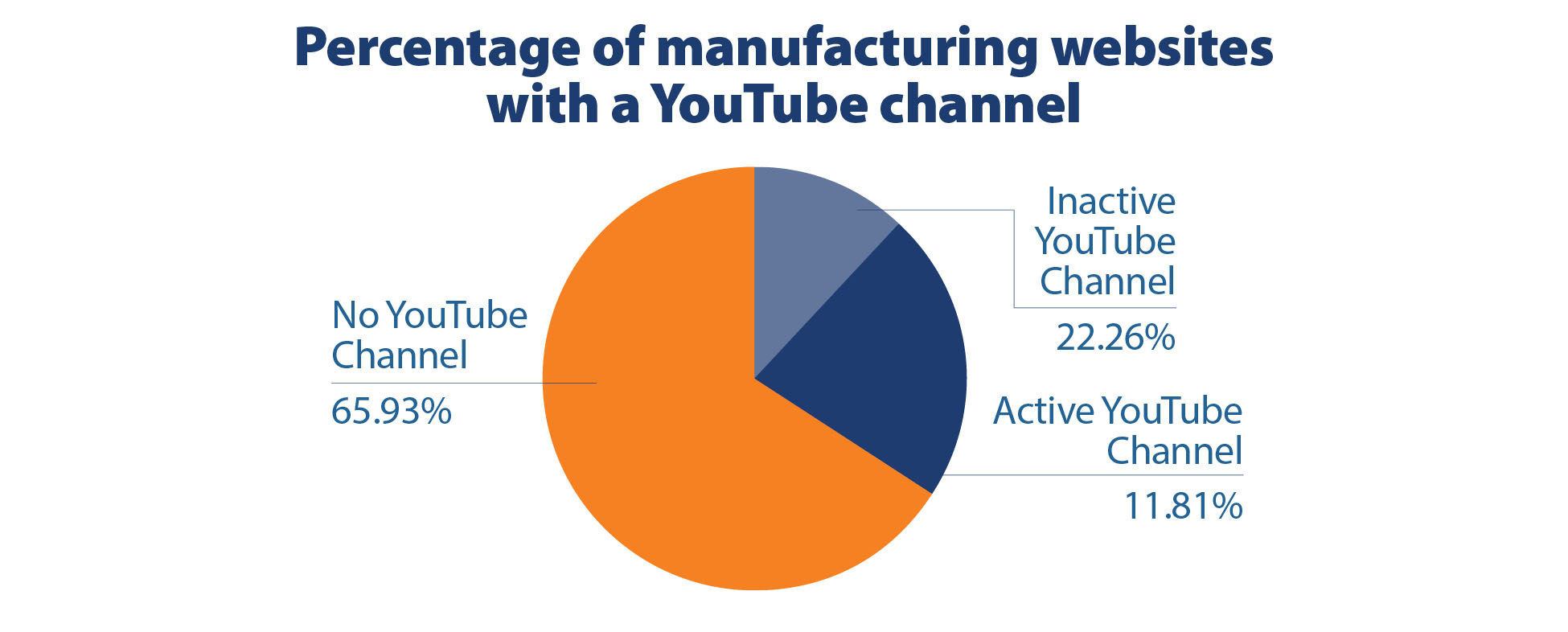
That same CMI survey found that 71% of the top performing B2B marketers use YouTube. According to Jeff Long of True Focus Media:
Video platforms are booming because video content is so effective … it’s still one of the best opportunities for manufacturers to leverage.
And Tim Wilborne of TW Controls, who is leveraging video content to the tune of 62K+ subscribers on his YouTube channel, adds that people use this content when they are looking for vendors.
They search (videos) to gather information when making decisions. And don’t forget, YouTube is the #2 search engine in the world.
51.4% of manufacturers are active on social media
The good news is that just over half of manufacturers show up on social media and are active. Not surprising, considering social media allows you to post your own content at no cost, and platforms like LinkedIn are home to millions of manufacturing buyers.
Still, over 39.5% of manufacturers are keeping information about their products and services to themselves.

That’s another huge opportunity missed, considering that 60% of U.S. B2B marketers found that social media is the most effective channel for driving revenue, according to Wpromote and Ascend2.
Jake Hall, The Manufacturing Millennial, agrees. The LinkedIn guru and prominent manufacturing influencer conducted a survey of engineers and decision-makers, asking them where they got their information. He found that 86% said it was from videos, YouTube, Google, or a company website. Only 7% said they talked to a sales rep:
Do trade shows to meet people and exchange information. But if you are only doing that AND NOT using social media, you are wasting money and losing customers.
Eddie Saunders Jr., the self-proclaimed (and actual) mascot of manufacturing, and LinkedIn famous kind of guy, echoes Jake:
Being active on social media provides numerous benefits to your brand and allows you to capitalize on attention you wouldn’t receive otherwise.
47.4% of manufacturers are providing white papers, guides, and tools like configurators
This middle-of-funnel content helps provide valuable insights that can drive business decisions. Just about half of the manufacturers understand this and are producing content such as product configurators or guides with product data.
But over half do not, which is a big miss when it comes to how customers are buying these days. Remember, according to the Challenger Sales Model, over 58% of the customer journey is completed online before a meaningful interaction with a salesperson occurs.
Despite this trend, only 47.4% of manufacturers publish middle-of-funnel content, which can provide insights that guide customers’ buying decisions.
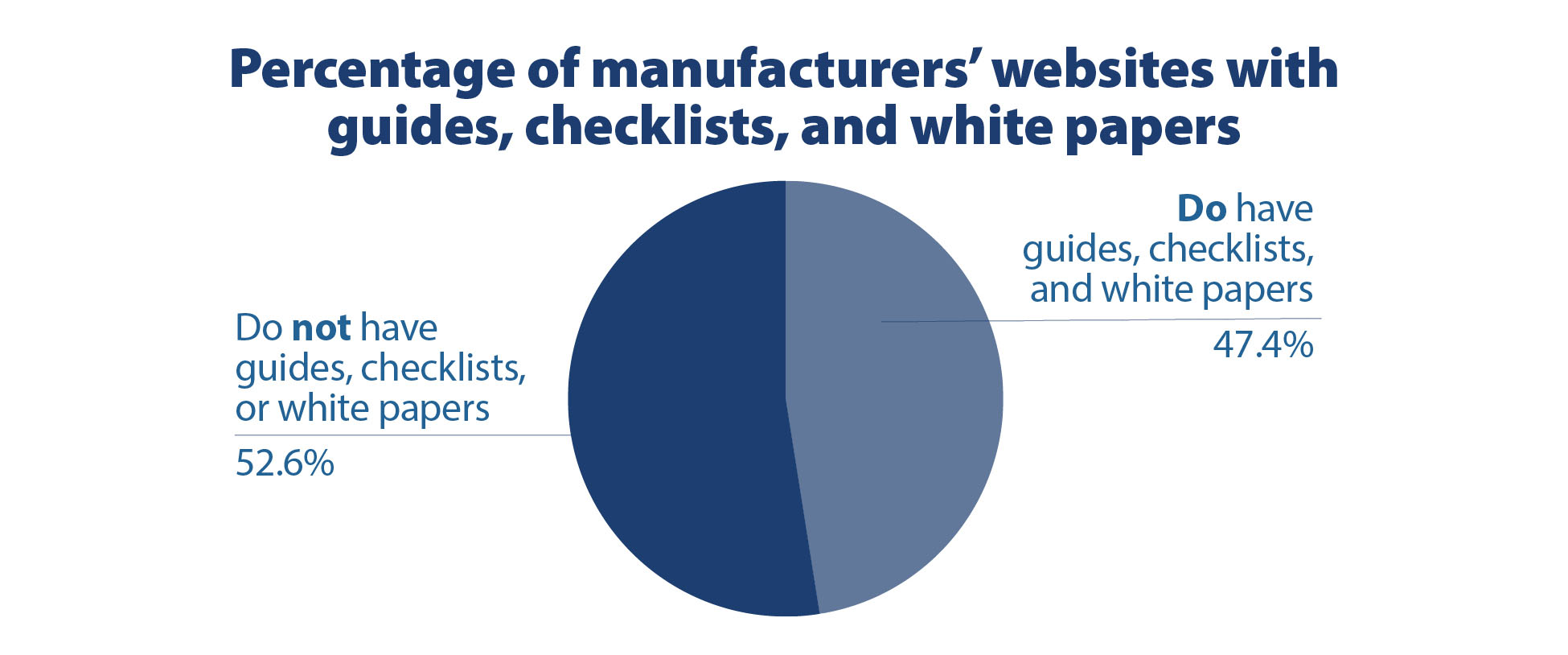
Kris Harrington, CEO of GenAlpha Technologies, notes that we’re in an era where these types of digital tools are reshaping B2B industries — and that manufacturers can’t fall behind.
The convergence of self-service trends and online expectations serves as a reminder of the need to leverage all available channels to connect with customers.
This type of content is also invaluable for helping manufacturers sell to multiple buyers of complex products, as Matt Dixon, Founding Partner of DCM Insights and co-author of The Challenger Sale and The JOLT Effect points out.
Creating an in-depth report with your insights can help them not only understand the solution, but they can use it to convince other members of the decision-making team.
Only 19.5% of manufacturers publish case studies, testimonials, and pricing
Even if you create top and mid-funnel content to get customers to Know You and Like You, one of the biggest obstacles remains: Getting them to Trust You.
The most effective way to establish trust with customers searching online is to rely on data and the words of your customers to tell your story.
A Demand Gen report revealed that 62% of B2B buyers cited a need for valid sources — such as case studies and testimonials — that offer a third-party perspective on products and services.
But manufacturers aren’t producing these types of “valid sources.” Consider that only 17.6% of manufacturers published case studies.
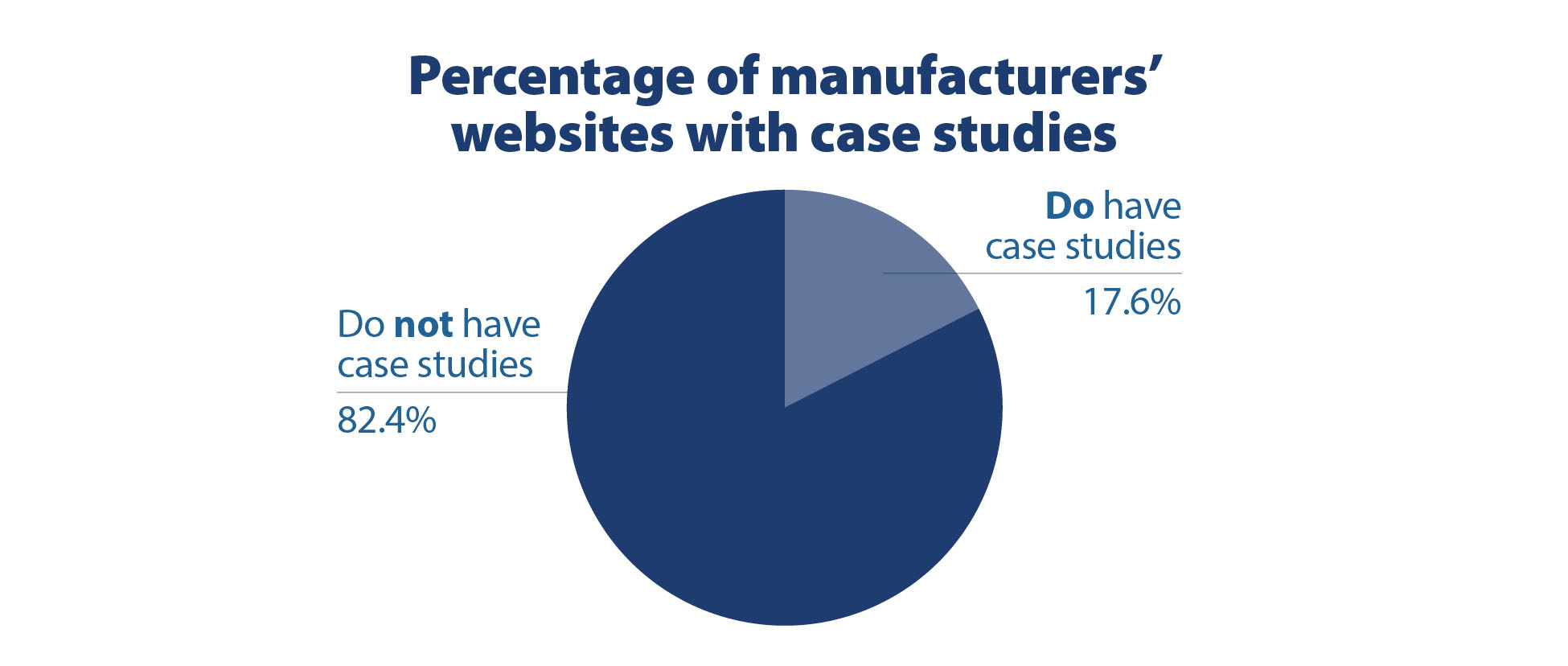
And only 19.6% had customer testimonials.

Finally, we looked at how many manufacturers were publishing any type of pricing information. Many manufacturers create complex products, and they’ve historically been reluctant to share pricing information.
The data reveals times haven’t changed. Only 14.3% of manufacturers feature pricing on their websites.

These trust-building pieces of content can provide the proof customers need to move from the status quo. David J.P. Fisher, President of RockStar Consulting, sums it up:
Trust allows us to take action when the outcome is uncertain.
Marcus Sheridan, author of They Ask, You Answer, doesn’t believe manufacturers are doing themselves any favors by withholding pricing information.
Customers will find out your pricing eventually, as well as your competitors’ pricing. And by publishing content with pricing, you are able to explain your pricing strategy and control the narrative.
By never discussing pricing at all, manufacturers are allowing ignorance to breed in the marketplace.
So what? Why can’t manufacturers just stick with the status quo?
Running a successful business is all about anticipating and reacting to marketplace trends. And if you’re looking at the data from the external research we mentioned earlier in this report, and combine it with our findings, you can draw these conclusions:
- Customers are making buying decisions based on online experiences.
- The manufacturers who are engaging online are showing success.
- The majority of the industry is not producing digital content.
So what does that mean for you?
Well, you can stick with the status quo and hope your peers will continue to do the same.
But if you have a growth mindset, you can view this as a golden opportunity to better serve today’s customers and jump ahead of competitors who are resistant to change.
